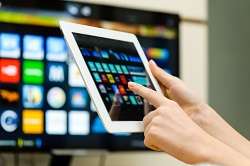One app for a smooth multi-device user experience

How do you watch television? Perhaps you move from a traditional cable or satellite broadcast to a streaming service on your PC, tablet or phone? Or maybe you like to 'multi-task' during TV time, checking the news on your smartphone or interacting with other viewers on Twitter and Facebook?
Clearly, the way we watch TV has drastically changed. However, the way television is broadcast has essentially remained the same.
The MEDIASCAPE (Dynamic Media Service Creation Adaptation and Publishing on Every Device) project is disrupting this dynamic by helping broadcasters provide a socially engaging and comprehensive entertainment experience. Instead of providing content either through a TV or a streaming service, with MEDIASCAPE broadcasters can seamlessly interact with viewers across multiple devices.
Turning to the app
The challenge is that many of today's applications are designed for a specific device, meaning broadcasters have to design, implement, distribute and maintain a set of complex apps tailored to each individual device. Enter MEDIASCAPE, who instead of focusing on the device, is looking to build consistency into the app itself – allowing it to run independently across multiple devices. Specifically, the project is providing the standardised technology developers need to create the connected service apps required for advanced multi-user services.
MEDIASCAPE provides access to an array of information on the various APIs (application program interface) and user-oriented media application prototypes that it's developing. Developers are then free to incorporate these prototypes into their own applications. Examples of prototypes already available include controlling an internet radio with a Chrome extension, along with several connected device applications for the Eurovision Song Contest.
Developers also have access to the Discovery API library, which provides an inventory of device-specific features. Here, when building an app, a developer can first reference the database to ensure their design is able to function across devices. Another useful feature pertaining to multi-device capability is the adaptation engine, one of the core technological components developed by MEDIASCAPE. This engine uses current context and device capabilities to dynamically assign certain parts of an application's content to a specific device.
A key technology coming from the project is the UI-engine library (User Interface Engine), which allows developers to create responsive and adaptive user interface layouts for multi-device media applications. This is important as, in the past, when facing a single-device user interface a developer had to first define CSS templates, then organise items in the layout, before finally creating a different template for each targeted device. With all the devices now being used, these templates can quickly add up. The UI-engine library offers a more versatile solution for creating responsive and adaptive User Interfaces depending on the multi-device context of the user.
A win-win-win for broadcasters
MEDIASCAPE's research and supported technology is benefiting users, broadcasters and developers alike. For example, thanks to MEDIASCAPE's technological breakthroughs, users can move from device to device – or use multiple devices simultaneously – without a break in content.
Broadcasters, on the other hand, can now create and provide a single application that reaches its target audience regardless of the device being used. From a developer's standpoint, creating apps for TV is now as easy as creating a basic HTML webpage - thereby enabling broader participation in their creation and increasing the range and diversity of potential applications.
More information: For more information please see the MEDIASCAPE project website: mediascapeproject.eu/
Provided by CORDIS





















